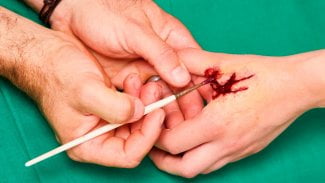České matky stárnou, potvrzuje Český statistický úřad. Zatímco v roce 1990 byl průměrný věk maminek při narození prvního dítěte kolem 25 let, o více než dvě dekády později se toto číslo blíží třicítce. V Praze dokonce průměrný věk prvorodiček převyšuje všechny ostatní kraje – první těhotenství tu žena prožívá ve věku bezmála 31,5 let. Je však tato stoupající tendence správná?
Cestování, kariéra, budování vztahu i bydlení, zábava, nezávislost. To bývají časté argumenty dnešních mladých dívek a žen na otázku, co od svého současného života čekají. Dítě se ve výčtu mnohdy objevuje až na pozdějších příčkách a bývá spojováno se vzdálenější budoucností, která zatím nemá konkrétnější obrysy. Věk třicet nebo dokonce čtyřicet let pro první těhotenství tak dnes již nepředstavuje nic nenormálního. Jak ale v tomto věku reaguje ženské tělo, jak žena snáší graviditu, porod i následné mateřství oproti mladším matkám?
Matkou ve dvaceti letech
V mladé dospělosti je tělo ženy po fyzické stránce na mateřství připraveno nejlépe. Podle gynekologů, porodníků i odborníků na reprodukční medicínu je ideální biologický věk prvorodičky 25 let. Žena je totiž plná sil a energie, kterou těhotenství, porod i záležitosti spojené s mateřstvím vyžadují. „Existuje tu také nižší riziko, že by se miminko nenarodilo v pořádku. Jsou-li oba rodiče zcela zdraví, není nutné obávat se genetických či vývojových vad dítěte. Také průběh těhotenství bývá u žen v mladém věku poklidný a neohrožují ho komplikace, jako je vysoký krevní tlak nebo cukrovka. Samotný porod pak bývá často přirozený a probíhá zpravidla standardně,” říká gynekolog a sexuolog Pavel Turčan.
Po porodu se mladé maminky také rychle zotavují, protože jejich tělo je stále pružné a dokáže se s nenadálým stavem vypořádat. Při péči o dítě rovněž pociťují menší únavu, vyčerpání a lépe odolávají stresu. Problematická však může být rovina psychická. Ženy v tomto věku často studují nebo jsou teprve na začátku své kariéry, a stojí tak před nelehkým rozhodnutím – zda upřednostnit dítě, nebo se pokusit zvládnout vše najednou.
Matkou ve třiceti letech
Na rozdíl od generace našich matek, které byly zvyklé rodit mezi 24. a 25. rokem života, je dnes docela běžné mít první dítě ve věku s trojkou na začátku. Odkládání rodičovství však s sebou přináší rizika. Plodnost se totiž po třicítce snižuje a šance na otěhotnění je menší. Zatímco pravděpodobnost otěhotnění u ženy ve dvaceti letech je 25 %, s překročením třicítky je to už jen 16 %, po 35. roce dokonce pouze 12 %. V tomto věku hrozí také vyšší riziko samovolných potratů. Čekárny reprodukčních klinik tak bývají často obsazeny právě věkovou skupinou 30+. „Českých párů, které využívají umělého oplodnění, je mnohem více, než by jich bylo, kdyby vše řešily dříve a včas. Lidé mají dnes bohužel často představu, že když uznají za vhodné mít konečně dítě, tak za devět měsíců přijde. Mnohdy už nepřemýšlejí o tom, že jim může početí trvat rok, dva či třeba tři,” potvrzuje Petr Galle ze společnosti Vegall Pharma, která dodává na trh přírodní přípravky, jenž pomáhají párům v početí. Třicetiletá prvorodička musí také počítat s tím, že se u miminka zvyšuje riziko výskytu abnormalit, a že tu je i možnost vícečetného těhotenství.
Porod je také častěji prováděn císařským řezem, protože žena ve třiceti letech už nemá tolik energie přivést dítě na svět přirozeně jako žena mladší. Zároveň se tak předejde komplikacím, které by mohly při standardním porodu nastat. Poporodní rekonvalescence probíhá po fyzické stránce déle a maminky bývají při péči o miminko také častěji unavené. Na druhou stranu mohou sobě i svému děťátku často poskytnout stabilní zázemí, na jehož budování měly dostatek času.
Matkou ve čtyřiceti letech
Důvodů, proč žena poprvé otěhotní teprve ve vyšším věku, může být více. Za touto skutečností může stát například rozhodnutí, že se žena na roli nastávající maminky dosud necítila, na denním pořádku bývají v tomto věku ovšem i komplikace s početím. Přesto však budoucí maminky, které oslavily 40. narozeniny, nejsou ničím výjimečným. Ačkoliv se tvrdí, že těhotenství s sebou s přibývajícím věkem přináší větší rizika, vždy je potřeba brát ohled na fyzický i duševní stav dané ženy. Přesto však zralé tělo nelze srovnávat s organismem dvacetiletých dívek. U starších prvorodiček dochází častěji k samovolným potratům – až z 34 %, těhotné ženy musejí mnohdy bojovat s těhotenskou cukrovkou či vysokým tlakem, častý bývá i porod císařským řezem.
- Přečtěte si: Jsme svědky epidemie císařských řezů
Dostává-li se dítě ven přirozenou cestou, trvá takový porod zpravidla déle. Také miminko se může narodit předčasně, anebo s nižší porodní váhou. Ačkoliv mnoho starších matek přivede na svět zcela zdravé dítě, je třeba myslet i na zvýšené riziko vrozených vad a vícečetného těhotenství. Přímo úměrná vyššímu věku prvorodičky je také doba, než se její tělo po porodu zase zregeneruje. Čtyřicátnice totiž už nemívají tolik sil a energie na mateřství. Výhodou oproti mladším matkám je však jejich vyzrálost, sebedůvěra, nadhled i větší psychická pohoda. Mateřství tak probíhá zpravidla v poklidu, vyrovnaně a bez většího stresu.
Zdroje: TZ Vegall Pharma














































